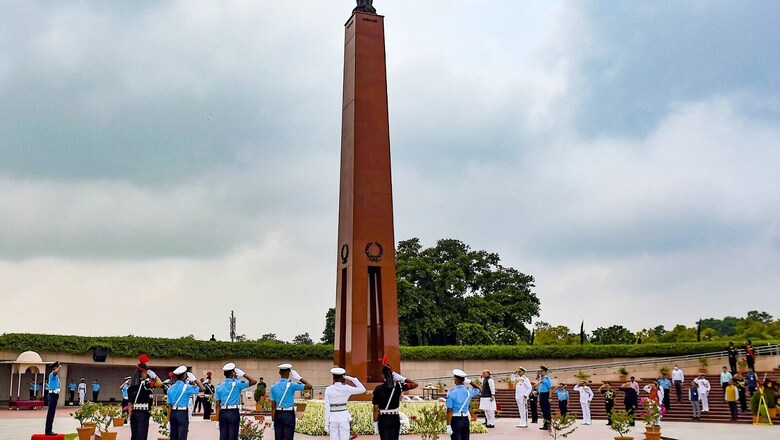
views
India celebrated the 23rd Kargil Vijay Diwas on July 26, 2022, to commemorate the sacrifices made by our soldiers in the Kargil conflict. After the Siachen conflicts, this was the second battle fought by any army at this altitude.
This war undoubtedly represents an example of high-altitude warfare in the Zanskar and Ladakh mountain ranges and highlights significant logistical and human resource and deployment problems. People have written a lot about how the conflict was fought at each flash point, starting from Mashko in the Drass sector to Chorbat La in the Batalik sector. But not many have written about the commendable work done by Engineer units, the “Sappers” who were inducted at a short notice with minimum equipment.
In December 1998, the Pakistan Army decided to infiltrate into Indian territory and occupy unoccupied/winter vacated posts in the Kargil and Batalik sectors, to control the area leading to Ladakh. Pakistani troops from the elite Special Services Group and five battalions of the Northern Light Infantry (a paramilitary regiment not part of the regular Pakistani Army at that time) backed by Kashmiri mujahideen, set up bases on vantage heights dominating the Kargil Highway.
Pakistan achieved a strategic surprise by establishing hundreds of posts inside Indian territory.
Around May 1999, intrusions by the Pakistani forces were detected by Indian patrols. Initially, the response from the Indian side was mute, but realising the level of intrusion, everything available was put into the battle to throw out the Pakistani intruders.
In the words of a Pakistani Army Officer: “But our joy of ‘doing a Siachen’ on Indian Army was short lived and heavens broke loose when the intrusions were first detected on 03 May 1999. After initial chaos & confusion, the Indians come upon us with all their fury. The skies lit up with artillery shells and there was never a comfortable moment for our boys after that.”
The Indian government and the Army’s response was all out with respect to force levels and warfighting equipment, which Pakistanis never expected.
Because of the nature of the terrain, large Corps size operations could not be mounted, and most of the fighting was at the unit level. The force level for successful operations needed high-class infrastructure for troops and logistic movement. The area of operation was devoid of any infrastructure. Narrow valleys and other flying constraints made any kind of air support in this sector impossible. Developing infrastructure in the area of operation became the primary responsibility of Army Engineers, a major enabler to us in all our successful battles.
Before the Pakistani intrusion, only one Indian brigade looked after an approximately 80-km sector. For Kargil operations, a division, along with several Arty and other units were inducted, a nightmare for logistic build-up, especially infrastructure development in the high-altitude mountainous terrain of Kargil and Batalik sectors.
The Engineer Units had to construct infrastructure and perform all engineer operational tasks in battle at each of the posts occupied by enemy intruders. Other than 411 Para Field Company and one detachment under Capt NP Singh of 108 Engineer Regiment, which held a post opposite to Pt 5353, none of the Engineer Regiments were directly involved in fighting the intruders, but they were significant enablers in the success of our fighting troops including preparation of deployment area’s for Arty units, movement of logistic and warfighting stores.
Engineer tasks were spread across the 80 km of intrusion areas. They needed heavy engineer regiment deployments. The initial engineer support to the 8 Mountain Divisional Sector during the Kargil War was provided by the Six Bombay Sapper Regiment along with detachments of 411 (Independent) Parachute Field Company.
106 Engineer Regiment was at Mashkoh and Batalik, while detachments of 411(Independent) Parachute Field Company were at Mashkoh and Pt 4905. Whereas 110 & 116 Engineer Regiments were at Drass, 108 Engineer Regiment was at Kargil and Batalik with 112, and 270 Engineer Regiments also in Batalik sector. 2 Engineer, a Madras Sapper Regiment, was in 3 Mountain Divisional Sector at Turtuk.
The first Officer to reach Drass from 8 Mountain Division for reconnaissance was CO 108 Engineer Regiment. On arrival, engineers got deployed to build several underground Command posts and various OP rooms, minor bridges and several helipads for movement of command elements and casualty evacuation. In the base areas, there was an immediate need to provide living/storage prefab shelters to protect troops and warfighting equipment from adverse effects of high altitude and weather.
Large-scale high-altitude prefab shelters were constructed at every base to house incoming and outgoing troops, ammunition, FOL, food, water, medical facilities of field ambulances and every other thing which came up for operations to ensure troops got the best they deserved.
Sappers tasks were upgrading/improving connectivity into the Drass and Batalik operational areas, provide foot/mule tracks to move ammunition/equipment, and, in some cases, L70 guns to forward areas to blast the enemy from bunkers before the attack.
They cleared mines, booby traps and obstacles laid by the Pakistani intruders. Some posts were so heavily booby-trapped that they required exceptional engineer effort to disarm them. Pakistani intruders had at several places booby-trapped their dead soldiers. In some particular areas, tactical mine fields were laid to prevent/canalise enemy withdrawal.
Sappers cleared mines/booby traps at several locations to give clear infantry safe lanes before they attacked the posts. Since Pakistanis had a head start, they were well-entrenched in dugout bunkers. Sappers had to provide banker bursting teams to blast them out of bunkers.
There was a mule track between Drass to Mashkoh valley. This track was one of the routes used by the Pakistani intruders to reach various posts they were occupying now. This track also provided us, options to attack multiple posts held by Pakistani intruders. This mule track was converted into OP road under heavy enemy Arty fire by 106 Engineer Regiment, a task beyond the unit’s capabilities at that stage. Another OP road from Muski Nala to Gurkha hill and Sapper point to Sando top was again constructed under heavy enemy fire. These OP roads were major enablers to our success in Mashkoh and Sando valleys, including Tiger Hill, Pt 4875, Pt 4590, Pt 5353 and Tololing heights. Many more Op roads were constructed under the direct enemy small arm and Arty fire in Batalik Sector and other areas which I am not naming due to security reasons.
In the words of a Company Commander of 112 Engineer Regiment in Batalik Sector: “We Engineers were immediately tasked to fortify the regained heights by infantry, climbing razor-sharp cliffs with no tracks. The posts could not be sustained unless tracks were made to carry ration/ ammunition on back or on mule. I was tasked by then Brigade Commander, 70 Brigade, to construct a track. I had to innovate to make a track of 400 metre on a 90-degree cliff to Pt 5465 (approx. 18500 ft) under heavy snow fall and enemy fire with no bullet proof jacket. For almost a week, my company could not make any progress due to heavy machine gun fire and inclement weather.”
Even with these difficulties, they achieved their targets well before time.
In the words of another Company Commander: “I was having a terrible time and had developed early signs of hypoxia. I took the decision and borrowed five bulletproof jackets from nearby infantry unit 1 BIHAR. My 2IC and I wore bullet proof jackets and took four volunteers since we all were terrified to face flying bullets raining from both Pakistani & our side. We kept working continuously to make a few meters of the track with a rock drill, silent explosives, shovel and pick axe.”
“Considering the restricted working area and enemy fire, a maximum of 10-15 people could only work at a time. In the next seven days, the track was ready for one person to climb. Earlier, infantry troops used to climb with a rope ladder that too after dark. On the other side, engineers were busy making other posts liveable for infantry troops. We suffered minor injuries but no fatal ones.”
Many heroic examples like this were common from Engineer Regiments in the other sectors. One of them was when Captain Rupesh Pradhan of 2 Engineer Regiment was de-mining, he located and destroyed more than 65 mines, exhibiting true leadership qualities with total disregard to his personal safety in the face of the enemy. He was critically injured while demining when one mine blew up in his face.
Captain Rupesh Pradhan displayed an act of gallantry of a very high order in the presence of the enemy and exemplary courage and dedication beyond the call of the duty with total disregard to personal safety, for which he was awarded the VrC. Outstanding leadership qualities were exhibited by various Commanding Officers and junior leadership. Engineer Regiments performed beyond the capabilities and capacity that is evident from the number of awards and the COAS Unit citations given to Sappers for tasks well-done.
I happened to improve these Op roads and tracks when I moved with my 102 Engineer Regiment to the 8 Mountain Division sector during December, 1999-January, 2000. My Regiment further enhanced the connectivity by constructing several cableways.
Major General Amin Naik, SM is an Arjuna awardee (veteran). He commanded 102 Engineer Regiment from 2000-2001 at Kargil as 8 Div Engineer Regiment. The views expressed in this article are those of the author and do not represent the stand of this publication
Read all the Latest News and Breaking News here




















Comments
0 comment